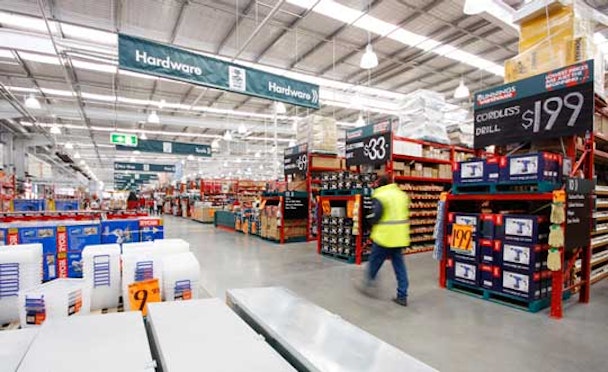The Bunnings brand in profile: What to expect from the impressive DIY retailer's arrival in the UK
What will the Australian DIY brand Bunnings bring to the UK? We asked Elmwood chairman Jonathan Sands, who knows the Australian market well with the brand design consultancy having a studio in Melbourne, to tell us about the retailer and what we can expect from its acquisition of Homebase.

Homebase stores will be rebranding to Bunnings, above
I first started working in Australia in 2004 with the supermarket retail chain Coles (then a subsidiary of Coles Myer) and I vividly remember coming across the Bunnings business in my first week as I started to get to grips with the retail landscape in Australia.
In truth my first experiences with Australian retail were somewhat underwhelming. The supermarkets were extremely poor in every way. Poor products, poor retail standards and in my view at least 10 years behind anything I'd seen in the UK…that is apart from Bunnings.
Indeed Bunnings was the polar opposite and in my view, quite simply, it was one of the best DIY stores I had seen anywhere in the world. And it still is. While its people and expertise are second to none – its customer service standards are truly world class and really set the benchmark – it was the product range that blew me away. Perhaps being in the land of 'the barbie' I should have expected its range of outdoor grills and barbecues to be a little better than in the UK, but nothing quite prepared me for the full outdoor kitchen experience. It almost put my own indoor kitchen to shame.
So what could Wesfarmers and Bunnings bring to the UK?
Well first of all, you have to look at what they have done on their home patch. Shortly after I started working with Coles, the business was acquired by Wesfarmers. It took over an ailing supermarket business with a tired retail estate and turned it into one of the best retail businesses in Australia, adding around $10bn in sales in the process and increasing margins at the same time over the period 2009 to 2015. So the first fundamental truth is that the leadership team know what they are doing.
Albeit from a lower base, Bunnings enjoyed a similar growth trajectory. And yet this is probably an even more remarkable story as during the same period the American DIY giant Lowes, in partnership with Woolworths (Coles' main supermarket competitor), opened its doors in Australia under the 'Masters' brand. With bigger buying power and greater technology at its fingertips, one might have expected Lowes to give Bunnings a run for its Aussie dollar. Interesting then, that the biggest retail story Down Under this week is not Bunnings' entry into the UK but Lowes' exit from Australia with a $3bn loss. So clearly Bunnings also knows what it is doing.
And so, as Lowes has experienced to its cost, just because a format works in your home market, it does not necessarily mean it will translate overseas. Our weather is fundamentally different (sadly) and so the product range itself will need to be thought through in context.
This said, I can't wait for Bunnings to arrive. On my frequent visits to its stores in Melbourne I have often thought to myself, "if only I could get this or that in the UK and at those prices for that quality". I am sure the incumbents at B&Q and Wickes will be bracing themselves and be ready with promotions and offers to try and spoil the Bunnings launch. This can only be good for the consumer as they will get better deals from the retail brands they know and new excitement and new products from the new comer to the party.
For me this is long overdue and should give the DIY market a much-needed injection of product inspiration and of course Aussie, Aussie, Aussie, go, go, go attitude. I will also be first in line for an outdoor kitchen, whatever our weather.
Jonathan Sands is chairman of Elmwood
